The Maqam Ibrahim
(Station of Abraham)
|
| The Maqam Ibrahim is located in front of the only door of the Kaba. Inside the building is a boulder about 2 x 3 feet in size and that claims to have the footprint of Abraham which was imbedded when his foot miraculously sank into the rock when he stood on it. Muslims believe (without proof) that this is the spot where Abraham used to perform prayers near the Kaba. They also believe he used it as a stepping stone to build the kaba. |
| You can see the symbol of the crescent moon on top of the Maqam Ibrahim beside the Kaba, as well as every mosque in the world. The historical connection with pagan moon worship is obvious. | 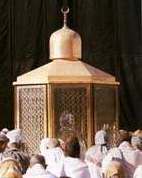 |
|
| You can see the Maqam Ibrahim in this photo, just to the right of the Kaba. |
| |
 The Black Stone
The Black Stone
(Hajar al-Aswad)
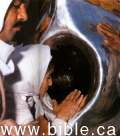
Occhigrosso (1996) affirms the moon God association and the astronomical basis of the black stone: "Before Muhammad appeared, the Kaaba was surrounded by 360 idols, and every Arab house had its god. Arabs also believed in jinn (subtle beings), and some vague divinity with many offspring. Among the major deities of the pre-Islamic era were al-Lat ("the Goddess"), worshiped in the shape of a square stone; al-Uzzah ("the Mighty"), a goddess identified with the morning star and worshiped as a thigh-bone-shaped slab of granite between al Talf and Mecca; Manat, the goddess of destiny, worshiped as a black stone on the road between Mecca and Medina; and the moon god, Hubal, whose worship was connected with the Black Stone of the Kaaba. The stones were said to have fallen from the sun, moon, stars, and planets and to represent cosmic forces. The so-called Black Stone (actually the color of burnt umber) that Muslims revere today is the same one that their forebears had worshiped well before Muhammad and that they believed had come from the moon. (No scientific investigation has ever been performed on the stone. In 930, the stone was removed and shattered by an Iraqi sect of Qarmatians, but the pieces were later returned. The pieces, sealed in pitch and held in place by silver wire, measure about 10 inches in diameter altogether and several feet high; they are venerated today in patched-together form.)" (Peter Occhigrosso, 1996 The Joy of Sects)
|
| Muslims believe (without proof) that the revered "black stone" (Alhajar Al-Aswad) is a special divine meteorite, that pre-dates creation that fell at the foot of Adam and Eve. It is presently embedded in the southeastern corner of the Kaba. Muslims touch and kiss the black stone during Hajj but non-Muslims are strictly forbidden to even touch it. |
| The stone has been attacked many times and is now composed of several pieces and fragments, bound together by a silver ligature. It is semicircular and measures about ten inches horizontally and twelve inches vertically. Here a woman and her husband touch the stone. | 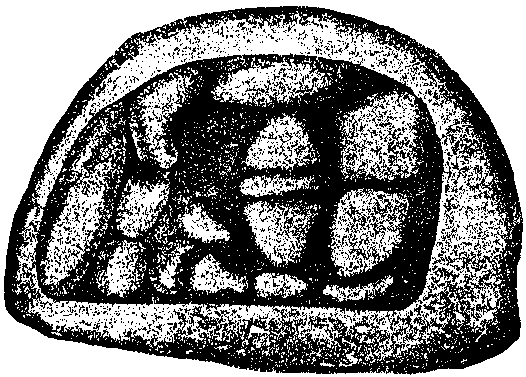 |
|
| It is presently embedded in the southeastern corner of the Kaba. Muslims touch and kiss the black stone during Hajj but non-Muslims are strictly forbidden to even touch it. |
| |
 The "Stand" on Mount Arafat
The "Stand" on Mount Arafat
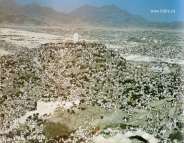 | 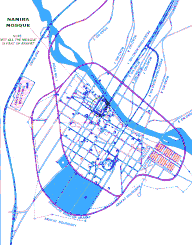 |
|
| On the 9th of Dhu al-Hijjah pilgrims leave Mina for the plain of 'Arafat for the wuquf, "the standing," the central rite of the hajj. In a re-enactment rite based upon a story of Muhammad, all are required to stand from midday to sunset in the very hot sun meditating. God told Christians such rites are valueless: "These are matters which have, to be sure, the appearance of wisdom in self-made religion and self-abasement and severe treatment of the body, but are of no value against fleshly indulgence." Col 1:23 |
| The plain of Arafat at the Mount of Mercy, is where Muhammad is supposed to have delivered his Farewell Sermon. |  |
| |
 The "Stone Throw" in Mina (the Rummy)
The "Stone Throw" in Mina (the Rummy)
| The throw: () Pilgrims walk to Mina where they throw 7 stones at stone pillars which represent the devil. This is based upon a mythical event in the life of Abraham. The Koran says that Abraham was told by God to sacrifice his only begotten son Ishmael. (all world history and the Bible says Isaac). On the way to make the sacrifice, the devil tried to convince Abraham not to sacrifice Ishmael. Abraham gathered up some stones and threw them at the devil until he disappeared. So Pilgrims throw 7 stones at the stone pillars in Mina which represent evil and the devil, reenacting the way Abraham threw stones at the Devil. | 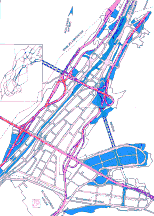 |
|
| The "Stone Throw" in Mina re-enactment ritual based upon an mythical event in the life of Abraham. The devil tried to talk Abraham out of sacrificing Ishmael (the Bible says Isaac). So Abraham threw stones at the devil till he disappeared. |
| Likewise, pilgrims stop at Mina to throw seven small stones at stone pillars which represent evil and the devil. | 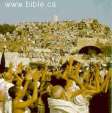 |
|
| 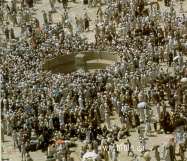 |
| |
 The "running"(The Sai) between Safa and Marwat
The "running"(The Sai) between Safa and Marwat
| The Run ( The pilgrim is required to make several brisk walks between the hills of Safa and Marwat in a re-enactment ritual based upon a mythical event in the life of Hagar and Ishmael. Muslims believe that these two hills of Safa and Marwat are where Hagar frantically ran back and forth seven times in search of water for her dying son, Ishmael. Hagar's found water to save Ishmael at the "well of Zamzam". So Pilgrims run back and forth between two hills of Safa and Marwat seven times and then go to the Zamzam well, beside Kaba. |
|
| The pilgrim is required to make several walks between the hills of Safa and Marwat in a re-enactment ritual. Muslims believe (without proof) that these two hills are where Hagar frantically ran back and forth seven times in search of water for her dying son, Ishmael. |
| Hagar's found water to save Ishmael at the "well of Zamzam". The area has been developed into a covered portico similar to an underground parking lot. | 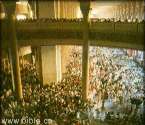 |
| |
 The Black Stone
The Black Stone
 The "Stand" on Mount Arafat
The "Stand" on Mount Arafat The "Stone Throw" in Mina (the Rummy)
The "Stone Throw" in Mina (the Rummy) The "running"(The Sai) between Safa and Marwat
The "running"(The Sai) between Safa and Marwat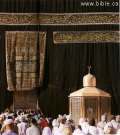

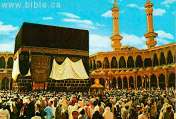
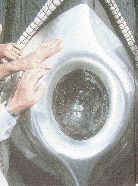

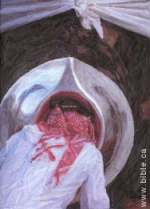


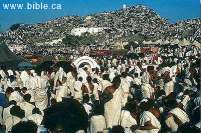


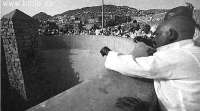

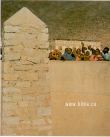

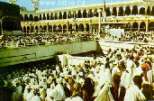

No comments:
Post a Comment